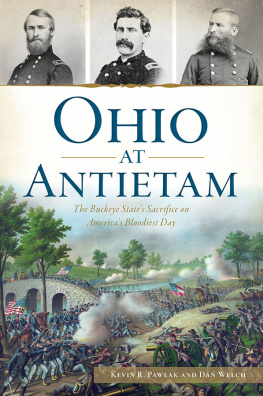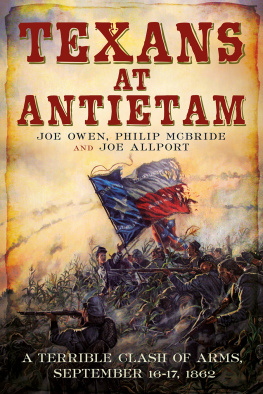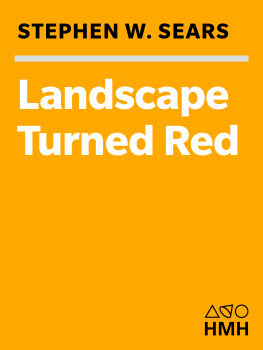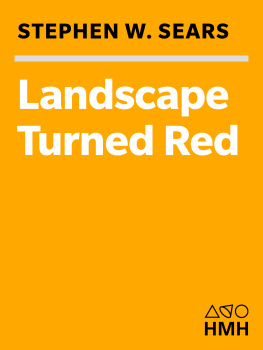For Marilyn Welkermy guide, my inspiration, my mother
Whoever stood in front of the corn field at Antietam needs no praise.
M AJOR R UFUS D AWES (1862),
Acknowledgments
Any work such as this is never the result of just one persons efforts, even if only one name is printed on the cover. While it is impossible to name all those who contributed their support, expertise, and knowledge to creating this volume, I want to note a few individuals who were particularly instrumental in making this book a reality. Jeffrey Fortaismy friend, brother-in-law, and fellow historiancreated the unsurpassed maps that grace this work and provided his own detailed, thorough cartographic research that informed my research. Without his contribution, it would be impossible for most readers to comprehend the often-complex movements that occurred in the Cornfield and elsewhere at Antietam. His ability to transform my simple sketches and vague ideas into such clear, concise maps is unique, and I could not have written this book without him. Ted Alexander, Antietam National Battlefields former chief historian, reviewed an early draft of my book and offered invaluable advice and insight. The rangers and volunteer staff of Antietam National Battlefield contributed both by maintaining a national treasuremaking it possible to walk the battleground of September 17, 1862and by always happily answering odd, highly detailed questionsthey are a model of true public service. I received tremendous assistance from the staffs of the National Archives, the Library of Congress, the US Armys Heritage and Education Center (formerly the Military History Institute), and the various universities, libraries, and historical societies listed in the notes and bibliographic entries at the end of this volume. Their unique knowledge and stewardship of Americas irreplaceable documents makes it possible to dig deep into the battlethey are all a national treasure in their own right. The living historians of the 3rd US Regular Infantry helped me better understand nineteenth-century military tactics and life, and they routinely served as a sounding board to test my ideas and theories about military movements and tactics employed in the Cornfield. My cousin, Robert W. Austin, who served in the 105th New York and survived wounding in the Cornfield, inspired me throughout this volumes creation and reminds me daily what it is to be an American. Lastly, and most importantly, this book would not be possible without the love and support of my wife, Margaret, and my children Rebecca and Thomas. Their patience with my spending too many days and evenings in front of the keyboard and their willingness to support my writing habits, whether wandering with me over obscure parts of Antietam Battlefield or enduring yet another visit to the Archives or Library of Congress, is the love that makes such a bookand anything in lifepossible.
List of Maps
Hookers Planned First Corps Attack
Rickettss AttackDuryees Advance
Gibbons Brigade Advances and Divides; Hartsuff Attacks
Lawtons and Hayss Brigades attack; Gibbon Nears Success; Starke Faces Disaster
Hoods Attack Opens
Hoods Attack Develops
Woffords Brigade Moves to the Left
Laws Brigade Advances
Meade Repulses Hoods Attack
Ripleys Brigade Takes the Cornfield
Crawfords Brigade Attacks the East Woods
Crawfords 128th Pennsylvania Attacks Ripleys Brigade
Colquitts Brigade Relieves Ripley; Gordons Brigade Enters the Fray
Colquitts Attack Stalls While Greenes Division Strikes the Flank
Greenes Division and Gordons Brigade Take the Cornfield
Greene and Gordon Await Sumners Arrival
Sumners Attack Begins; Gormans Brigade Enters the West Woods
McLaws Counterattacks
McLaws Attacks, Sedgwick Breaks
McLawss Attack Stalls
Greenes Division Breaks Lees Line in the West Woods
Pleasontons Calvalry Division Advances in the Center
Greenes Division is Driven from the West Woods
Franklins VI Corps Deploys as Cookes and Cobbss Brigades Attack
Slocums Division Prepares to Attack
Stuarts Calvalry Seeks to Turn the Union Right

The ford near the Upper Bridge, where most troops engaged in and around the Cornfield crossed Antietam Creek. (Battles and Leaders)

A c . 1890 view of the northern fence and end of the Cornfield, along with the southern end of the East Woods, looking eastward. This view offers some idea of the undulating terrain and how Ricketts and Doubledays attacking Union brigadeswho would move over the horizon on the rightcould disappear from view before reaching Jacksons Confederate salient. (Rare Images of Antietam, Another Software Miracle, LLC)

A 1906 view of the D. R. Miller farm, looking south. The house is on the left of the photo, with the springhouse in the center and the Millers barn on the right. The Hagerstown Pike bisects the picture. Gibbons Brigade was the first to advance over this ground, moving southward. (Antietam National Battlefield)

Austin Stearns sketch of himself in the Cornfield after being wounded during the advance of Hartsuffs Brigade. (Associated University Press, used with permission)

Private Austin Stearns of the 13th Massachusetts. Though wounded in the Cornfield, he would endure many more battlesincluding Fredericksburg, Gettysburg, Cold Harbor, and Petersburgbefore being discharged in August 1864 and returning home to Boston. (Associated University Press)
















